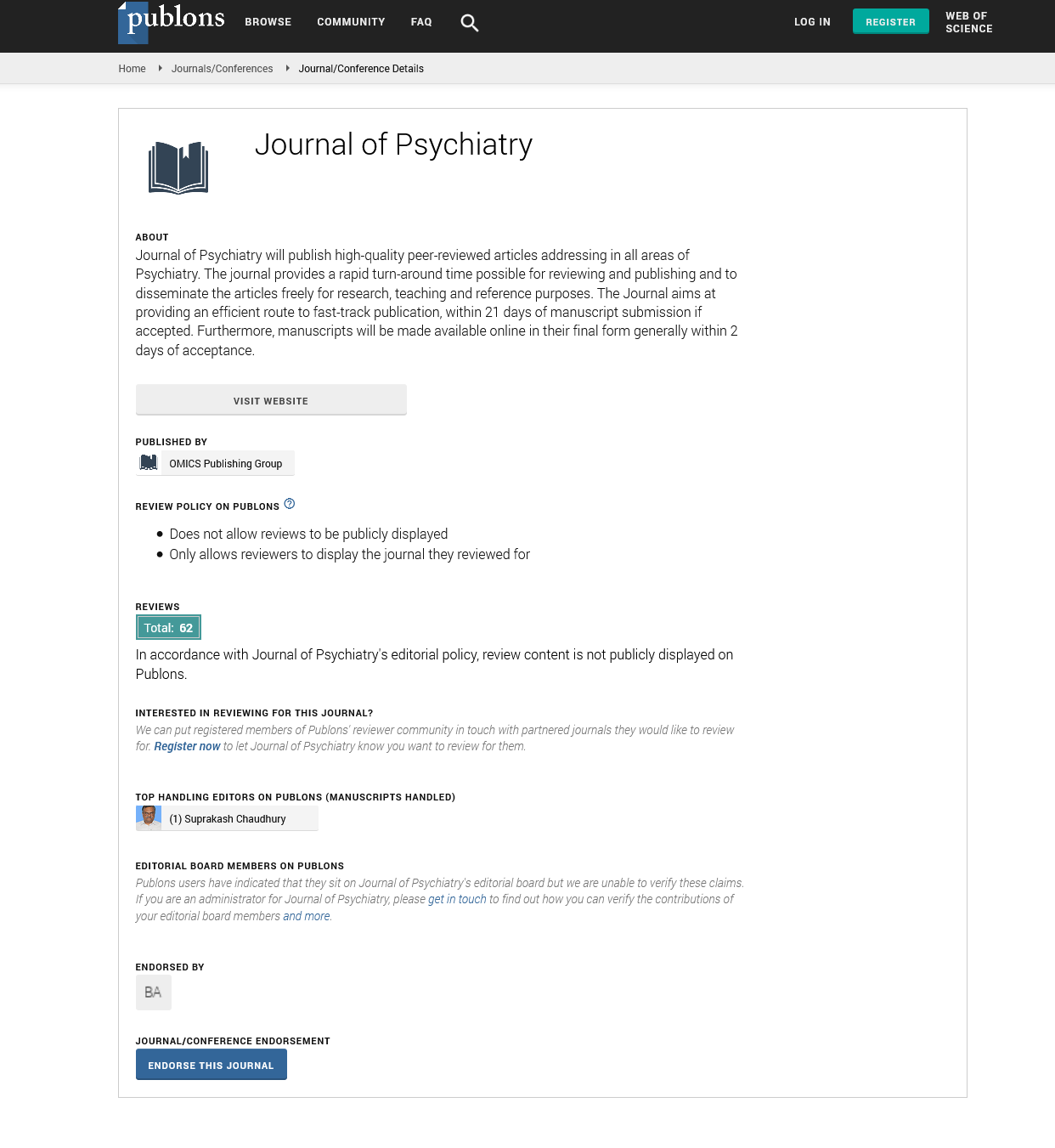PMC/PubMed Indexed Articles
Indexed In
- RefSeek
- Hamdard University
- EBSCO A-Z
- OCLC- WorldCat
- SWB online catalog
- Publons
- International committee of medical journals editors (ICMJE)
- Geneva Foundation for Medical Education and Research
Useful Links
Share This Page
Open Access Journals
- Agri and Aquaculture
- Biochemistry
- Bioinformatics & Systems Biology
- Business & Management
- Chemistry
- Clinical Sciences
- Engineering
- Food & Nutrition
- General Science
- Genetics & Molecular Biology
- Immunology & Microbiology
- Medical Sciences
- Neuroscience & Psychology
- Nursing & Health Care
- Pharmaceutical Sciences
Psychosomatic dysfunction in rasopathies
International Summit on Psychiatry and Psychology - July 25, 2022 | Webinar
July 25, 2022 | Webinar
Ramachandran Muthiah
Morning star hospital, India
Scientific Tracks Abstracts: J Psychiatry
Abstract:
Rasopathies are resulting from germline mutations of the proto-oncogene HRAS. Many of these mutations affect SHP2, SOS1, RAS, RAF and MEK proteins. Dr. White says. a group of related disorders including Costello syndrome, Noonan syndrome (NS), cardiofaciocutaneous (CFC) syndrome, and neurofibromatosis 1 (NF1), caused by abnormal functioning of the Rasâ?mitogenâ?activated protein kinase (RAS/MapK) pathway. Ras/MAPK pathway is an essential signaling pathway that controls the cell proliferation, differentiation, survival and its dysregulation causes clinically overlapping genetic disorders, called as ‘Rasopathies’. In this pathway, Ras, a GTPase, transmits the extracellular signaling from the receptor tyrosine kinases to two serine/threonine kinases (Raf and MEK) and, finally, to the activation of MAPKs. She has led the implementation of exome sequencing (a genomic technique for sequencing all of the protein-coding regions of genes in a genome known as the exome) at The Royal Children’s Hospital and the Murdoch Children’s Research Institute (Melbourne, Australia). Aoki et al. discovered that these germline mutations altered the residues Gly12 and Gly13 in HRAS's P-loop and had been identified previously as somatic defects in various tumors. Rasopathies are developmental disorders characterised by postnatal growth inhibition with delayed skeletal maturation and psychomotor retardation. In 2009, gainof- function missence mutation in SHOC2, C4a> G(Ps2g), identified in NS-like syndrome with loose anagen hair, severe intellectual disability, hypernasal voice and skin abnormalities. HRAS consists of six exons. Five exons code for a protein of 189 amino acids with a molecular weight of 21 kd. Alternative splicing, excluding the residues 152–165, gives rise to a protein of 170 amino acids. The nucleotide substitution as c.34G>A, resulting in p.Gly12Ser amino acid change is the most common (65/81 or 80%). The c.35G>C nucleotide resulting in p.Gly12Ala was seen in seven individuals (9%). Recently, 12 individuals with p.Gly13Cys change were identified, making this the most common amino acid change affecting the glycine in Position 13. Somatic mutation hotspots are bases encoding the glycines in Positions 12 and 13 and the glutamine in Position 61. Missense mutations at these positions lead to increased activity of the gene product. Germline mutations affect similar codons, it can be inferred that they have a similar effect on the gene product. The splicing efficiency of activating HRAS mutations can determine the rasopathy phenotype and frequency in Cancer. This unravels a potential for the development of new anti-cancer therapies based on SSO-mediated HRAS exon 2 skipping. Gene correction of these germline mutations to restore the normal protein functions is anticipated as a new therapeutic option. Neurocognitive involement is a common feature of rasopathies. Isoprenylation involves the enzyme farnesyl transferase(FTase) transferring a farnesyl group from farnesyl pyrophosphate (FPP) to the pre-Ras protein. Pathway modulators or small molecule inhibitors such as statins causes significant improvement in verbal and nonverbal memory, visual attention & efficacy by inhibiting the posttranscriptional lipid modification of RAS. RAF-1 inhibition by C-type Natriuretic Peptide (CNP) improved the bone growth in animal models and it is a potential targeted therapeutic drug to improve the stature of patients affected with disruption of the RAS/MEK/ERK pathway. Oxidative stress- play a role in cancer development and free radicals determine the non-neoplastic clinical features such as elastin anomalies, alteration of skin and appendages, developmental retardation and cardiac defects. PAR therapy (potassium ascorbate with ribose) causes a reduction in oxidative stress biomarkers in parallel with improvement of clinical features. It combines the antioxidant action of vitamin C with stabilizing intracellular effects of potassium and results in improvement of skin and appendage lesions, better evolution of psychomotor development, no progression of heart hypertrophy, nor tumor development. It is low cost, no side-effects, orally administered and useful for all genetic syndromes.
Biography :
Ramachandran Muthiah, Consultant at Zion hospital, Azhagiamandapam and Morning Star hospital, Marthandam, Kanyakumari District, India. Born on 10/5/1966 at keezhkulam village and father Muthiah belongs to enayam thoppu and mother Swornam belongs to Palaninta vilai, keezhkulam-629193 (+914651 203014) and both were farmers. Got married with an agricultural scientist Rajula shanthy and has one son R. Jeremy and now living with R.Russulsy. Completed primary education at Anaan vilai, keezhkulam and secondary education at Concordia Higher secondary school, Pootteti, MBBS in 1988 (Madurai Kamaraj), M.D. in 1996, D.M. in 2003, Dr.MGR Medical University, Chennai, 6 months course in Interventional cardiology at Batra Hospital, New Delhi in 2006 ( Ministry of health, Govt of India). Worked as medical officer in Rural health services for 5 years (keezhachekkarakudi, Aryappapuram Primary health centres, ESI hospital, Singanallur, coimbatore), teaching category as Assistant Professor at Madras, Coimbatore and Thoothukudi medical colleges. Marital life and job position get troubled with police arrests, brutal assaults, killing attempts and jail imprisonments happened in kerala state and police arrest, mental hospital transfer and psychiatric custody happened in tamil nadu state. Published papers in Cardiosource, American College of Cardiology Foundation, Case Reports in Clinical Medicine (SCIRP) and Journal of Saudi Heart Association.

